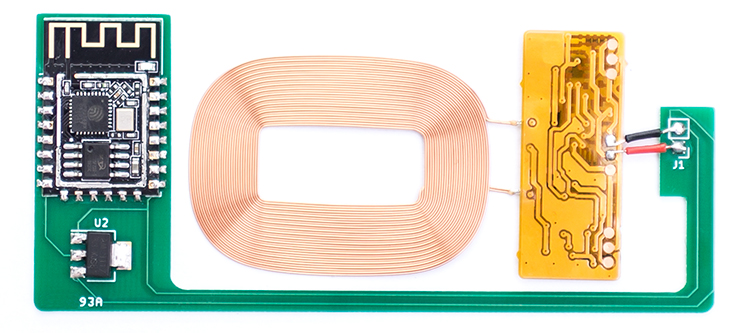Opencoil/electronics: Difference between revisions
(Created page with "# opencoil-paracity: electronics  *Assembled pcb* ## Bill of Materials * PCB: Send the gerbers from this repo to your fab of choice. * ESP12F: Widely available. * AM1117 3.3v Regulator: Widely available. * QI compatible wireless charging coil delivering 5v and > [500 mA](https://docs.ai-thinker.com/_media/esp8266/docs/esp-12f_product_spe...") |
No edit summary |
||
| Line 3: | Line 3: | ||
https://git.vvvvvvaria.org/then/opencoil-paracity/raw/branch/master/electronics/esp-wireless-charging-pcb/pcb-ass.jpg | |||
*Assembled pcb* | *Assembled pcb* | ||
Revision as of 20:31, 28 August 2022
- opencoil-paracity: electronics

- Assembled pcb*
- Bill of Materials
- PCB: Send the gerbers from this repo to your fab of choice.
- ESP12F: Widely available.
- AM1117 3.3v Regulator: Widely available.
- QI compatible wireless charging coil delivering 5v and > [500 mA](https://docs.ai-thinker.com/_media/esp8266/docs/esp-12f_product_specification_en.pdf): For example [this](https://aliexpress.com/item/4001154059743.html), search keywords: "pcba receiver module qi". Alternatively you could repurpose 'adaptor coils' advertised to convert non-QI phones to wireless charging, such as [these](https://www.pearl.de/mtrkw-9811-qi-kompatible-receiver-pads.shtml)*.
- NOTE**: Be aware that these 'adaptor coils' could contain additional circuitry that condition the output for use with specific mobile phones (the pearl.de ones do). Below is a guide to modify the 'pearl' coils to deliver maximum voltage (5v)constantly, instead of switching to low power, 2.5v output when not enough/too much current is drawn.
- Modding 'adaptor coils'
If you have soldered all components together and your ESP12f won't boot, you might have to modify your charging coil+circuit a bit. To make sure it's the coil, measure the output of the coil's electronics on the + and - (GND) terminals. If your multimeter reads ~2.5 volts you need to modify the circuit. (Disclaimer: the exact details on how this circuit works are yet unclear, comparing to a working coil revealed several differences in the electronics, matching them up made the non working coil output the needed 5v).
- Step 1
You need to desolder two IC's/ chips following the (visual) guide below. The electronics and coil are sandwiched between two layers of foil. To peel the foil away look for an opening near the lightning connector.
 )
)
 )
)
You are then left over with the bare coil and flexible pcb. Here I already desoldered the lightning connector flex pcb.
 )
)
Remove the following chips indicated by the following silkscreen printing:
- Q3 (chip markings: p7)
- Q4 (chip markings: wsc7)
 )

 )
)
A hot air reworking station + tweezers will make quick work of that (settings: 1 second on 320deg, moderate airflow). Without hot-air you could try a soldering iron or fine wire-cutters to simply cut away the chips. The flexible PCB is very fragile though.
 )
)
Step 1 completed!
 )
)
- Step 2
With both chips removed, you have to bridge two of the three (now) bare connections of the transistor Q4. I could not find a datasheet on this transistor so please refer to the photo's to see which pins.
 )
)
Done!
 )
)